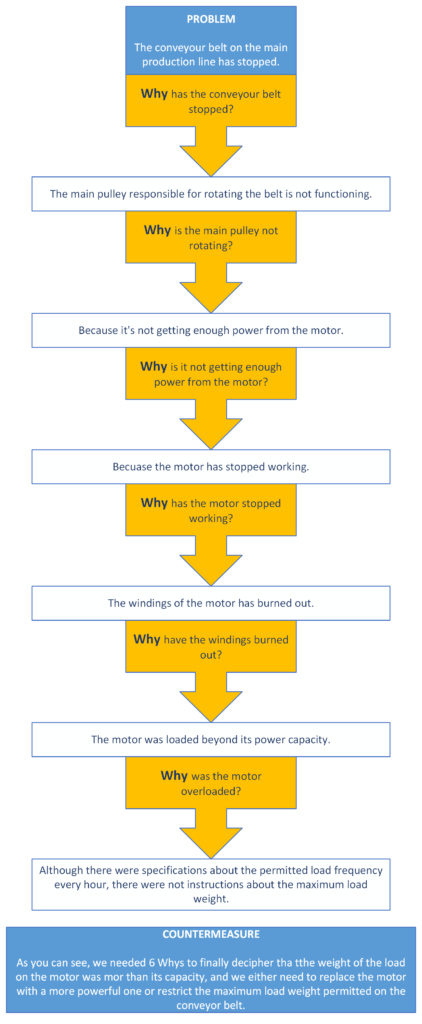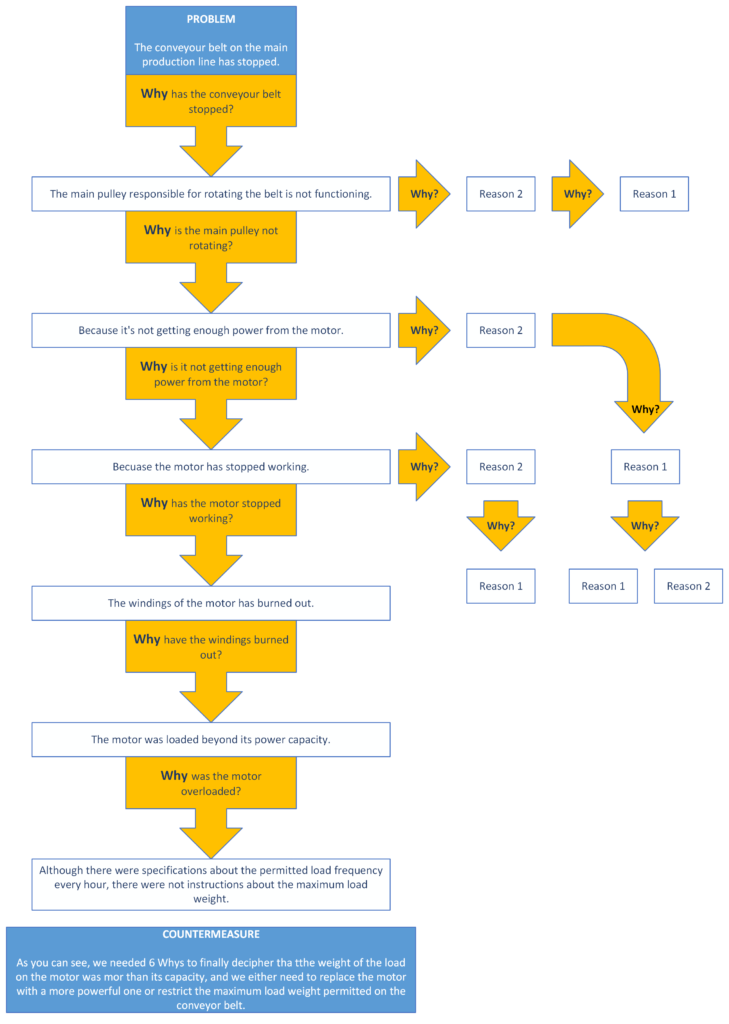5 Whys Root-Cause Analysis
Have you ever had a problem that refused to go away? No matter what you did, sooner or later it would return, perhaps in another form. These problems can be either work related or life related but the use of the 5 Whys was developed to address issues that arise in the business area and allows for a way to get to the root of the issue.
Stubborn or recurrent problems are often symptoms of deeper issues. “Quick fixes” may seem convenient, but they often solve only the surface issues and waste resources that could otherwise be used to tackle the real cause. These “quick fixes” are not addressing the root cause.
The application of the 5 Whys is a simple but powerful tool for cutting quickly through the outward symptoms of a problem to reveal its underlying causes – so that the issue can be dealt with and resolved at the root which usually stops the problem from resurfacing.
Origins of the 5 Whys Technique
Sakichi Toyoda, the Japanese industrialist, inventor, and founder of Toyota Industries, developed the 5 Whys technique in the 1930s. It became popular in the 1970s, and Toyota still uses it to solve problems today.
Toyota has a “go and see” philosophy. This means that its decision making is based on an in-depth understanding of what’s actually happening on the shop floor, rather than on what someone in a boardroom thinks might be happening. “Go and see” is another foundational philosophy of Lean and is essential to build facts and not making gut decisions.
The 5 Whys technique is true to this tradition, and it is most effective when the answers come from people who have hands-on experience of the process or problem in question.
The method is remarkably simple: when a problem occurs, you drill down to its root cause by asking “Why?” five times (5 times is a rule of thumb). Then, when a countermeasure becomes apparent, you follow it through to prevent the issue from recurring.
Note:
The 5 Whys uses “countermeasures,” rather than “solutions”. A countermeasure is an action or set of actions that seeks to prevent the problem from arising again, while a solution may just seek to deal with the symptom. As such, countermeasures are more robust, and will more likely prevent the problem from recurring.
When to Use a 5 Whys Analysis
You can use 5 Whys for troubleshooting, quality improvement, and problem solving, but it is most effective when used to resolve simple or moderately difficult problems.
It may not be suitable if you need to tackle a complex or critical problem. This is because 5 Whys can lead you to pursue a single track, or a limited number of tracks, of inquiry when, in fact, there could be multiple causes. In cases like these, a wider-ranging method such as Cause and Effect Analysis or Failure Mode and Effects Analysis may be more effective.
The 5 Whys works on the premise that “Every problem has a cause behind it, but a superficial analysis will only depict symptoms. A persistent inquiry is required to find the real cause (the root cause) behind the issue so that lasting solutions can be taken and the problem doesn’t resurface.”
This simple 5 Whys technique, however, can often direct you quickly to the root cause of a problem. So, whenever a system or process isn’t working properly, give it a try before you embark on a more in-depth approach – and certainly before you attempt to develop a solution.
How to Use the 5 Whys
The 5 Whys model follows a very simple seven-step process:
Step 1. Assemble a Team
Gather together people who are familiar with the specifics of the problem, and with the process that you’re trying to fix. Include someone to act as a facilitator, who can keep the team focused on identifying effective countermeasures.
Step 2. Define the Problem
If you can, observe the problem in action. Discuss it with your team and write a brief, clear problem statement that you all agree on. For example, “Team A isn’t meeting its response time targets” or “Software release B resulted in too many rollback failures.”
Then, write your statement on a whiteboard or sticky note, leaving enough space around it to add your answers to the repeated question, “Why?”
Step 3. Ask the First “Why?”
Ask your team why the problem is occurring. (For example, “Why isn’t Team A meeting its response time targets?”)
Asking “Why?” sounds simple, but answering it requires serious thought. Search for answers that are grounded in fact: they must be accounts of things that have actually happened, not guesses at what might have happened.
This prevents 5 Whys from becoming just a process of deductive reasoning, which can generate a large number of possible causes and, sometimes, create more confusion as you chase down hypothetical problems.
Your team members may come up with one obvious reason why, or several plausible ones. Record their answers as succinct phrases, rather than as single words or lengthy statements, and write them below (or beside) your problem statement. For example, saying “volume of calls is too high” is better than a vague “overloaded.”
Step 4. Ask “Why?” Four More Times
For each of the answers that you generated in Step 3, ask four further “whys” in succession. Each time, frame the question in response to the answer you’ve just recorded.
Step 5. Know When to Stop
You’ll know that you’ve revealed the root cause of the problem when asking “why” produces no more useful responses, and you can go no further. An appropriate counter-measure or process change should then become evident. (As we said earlier, if you’re not sure that you’ve uncovered the real root cause, consider using a more in-depth problem-solving technique like Cause and Effect Analysis, Root-Cause Analysis, or FMEA.)
If you identified more than one reason in Step 3, repeat this process for each of the different branches of your analysis until you reach a root cause for each one.
Step 6. Address the Root Cause(s)
Now that you’ve identified at least one root cause, you need to discuss and agree on the countermeasures that will prevent the problem from recurring.
Step 7. Monitor Your Measures
Keep a close watch on how effectively your countermeasures eliminate or minimize the initial problem. You may need to amend them, or replace them entirely. If this happens, it’s a good idea to repeat the 5 Whys process to ensure that you’ve identified the correct root cause.
5 Whys Examples?
The two diagrams below show an example of 5 Whys in action. Figure 1 is an example of a single lane of inquiry.
Figure 1: 5 Whys Example (Single Lane)

The 5 Whys method also allows you to follow multiple lanes of inquiry. An example of this is shown in Figure 2, below.
In our example, asking “Why was the delivery late?” produces a second answer (Reason 2). Asking “Why?” for that answer reveals a single reason (Reason 1), which you can address with a countermeasure.
Similarly, asking “Why did the job take longer than expected?” has a second answer (Reason 2), and asks “Why?” at this point reveals a single reason (Reason 1). Another “Why?” Here identifies two possibilities (Reasons 1 and 2) before a possible countermeasure becomes evident.
There is also a second reason for “Why we ran out of printer ink” (Reason 2), and a single answer for the next “Why?” (Reason 1), which can then be addressed with a countermeasure.
Figure 2: 5 Whys Example (Multiple Lanes)

Appreciation
A similar question-based approach known as “appreciation” can help you to uncover factors in a situation that you might otherwise miss.
It was originally developed by the military to assist commanders in gaining a comprehensive understanding of any fact, problem or situation. But you can also apply it in the workplace.
Starting with a fact, you first ask the question, “So what?” – in other words, what are the implications of that fact? Why is this fact important?
You then continue asking that question until you’ve drawn all possible conclusions from it.
The major difference between this and the 5 Whys technique is that appreciation is often used to get the most information out of a simple fact or statement, while 5 Whys is designed to drill down to the root of a problem.
Note:
Bear in mind that appreciation can restrict you to one line of thinking. For instance, once you’ve answered your first “So what?” question, you might follow a single line of inquiry to its conclusion. To avoid this, repeat the appreciation process several times over to make sure that you’ve covered all bases.
Advantages of the 5 Whys technique
- Encourages collaborative problem solving
- Builds a feeling of openness within the team as the outlook of every member is considered
- Simple, easy to follow without requiring any statistical analysis or additional tools
- Aids in reaching amicable consensus on areas with issues rather than fault-finding or blaming individuals
Limitations of the 5 Whys technique
- 5 Whys is a time-consuming technique and involves deep probing and thorough evaluation of all the facts
- 5 Whys cannot be done in isolation and need the availability of the associated team members
- Sometimes it’s not possible to isolate a single root cause through this technique
- The facilitators should be experienced enough to be able to ask the ‘right’ Why question
- The success of this technique depends upon its participants, i.e., if relevant people are not available, the remaining group may not be able to find the correct answer to the Why question.
5 Whys Technique – Tips and Best Practices
- Never do root cause alone, as independently, you will never be able to reach the very crux of the problem.
- Ensure there is a consensus among the team members while drafting the problem statement.
- Don’t stop at only 5 Whys and see if the problem can still be broken down. More complex issues might require further investigations.
- The technique should also be used in conjunction with other methods where quantitative data can validate the findings of 5 Whys.
- It’s the process that should be evaluated and not the people. Go past people’s mistakes and see process flaws.
- Try to move quickly from one question to the next. That way, you’ll have the full picture before you jump to any conclusions.
- The “5” in 5 Whys is really just a “rule of thumb.” In some cases, you may need to ask “Why?” a few more times before you get to the root of the problem. In other cases, you may reach this point before you ask your fifth “Why?” If you do, make sure that you haven’t stopped too soon, and that you’re not simply accepting “knee-jerk” responses.
- Know when to stop! The important point is to stop asking “Why?” when you stop producing useful responses.
Summary
The 5 Whys strategy is a simple, effective tool for uncovering the root of a problem. You can use it in troubleshooting, problem-solving, and quality-improvement initiatives.
Start with a problem and ask why it is occurring. Make sure that your answer is grounded in fact, and then ask the question again. Continue the process until you reach the root cause of the problem, and you can identify a countermeasure that will prevent it from recurring.
Bear in mind that this questioning process is best suited to simple or moderately difficult problems. Complex problems may benefit from a more detailed approach, although using 5 Whys will still give you useful insights.




